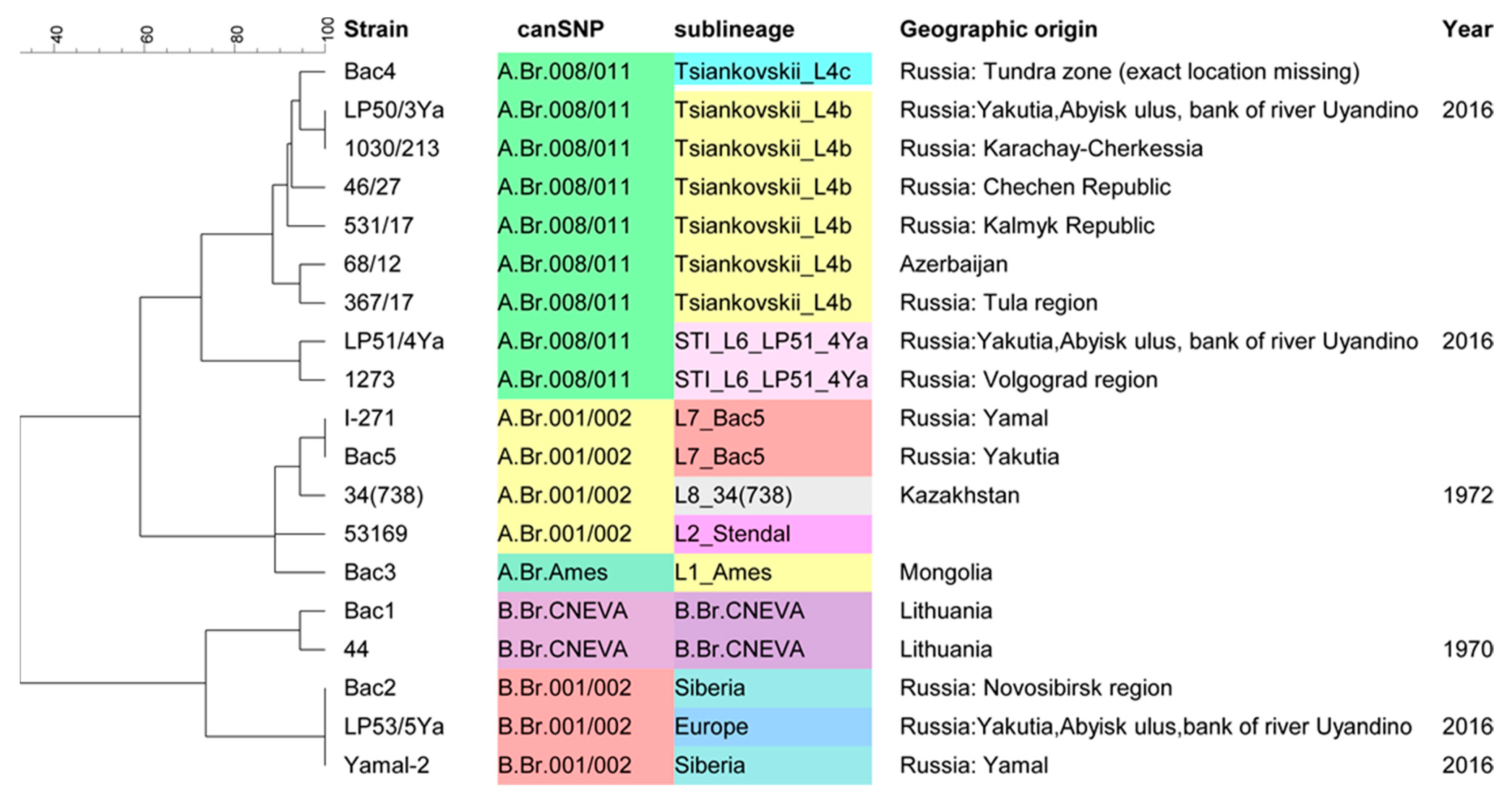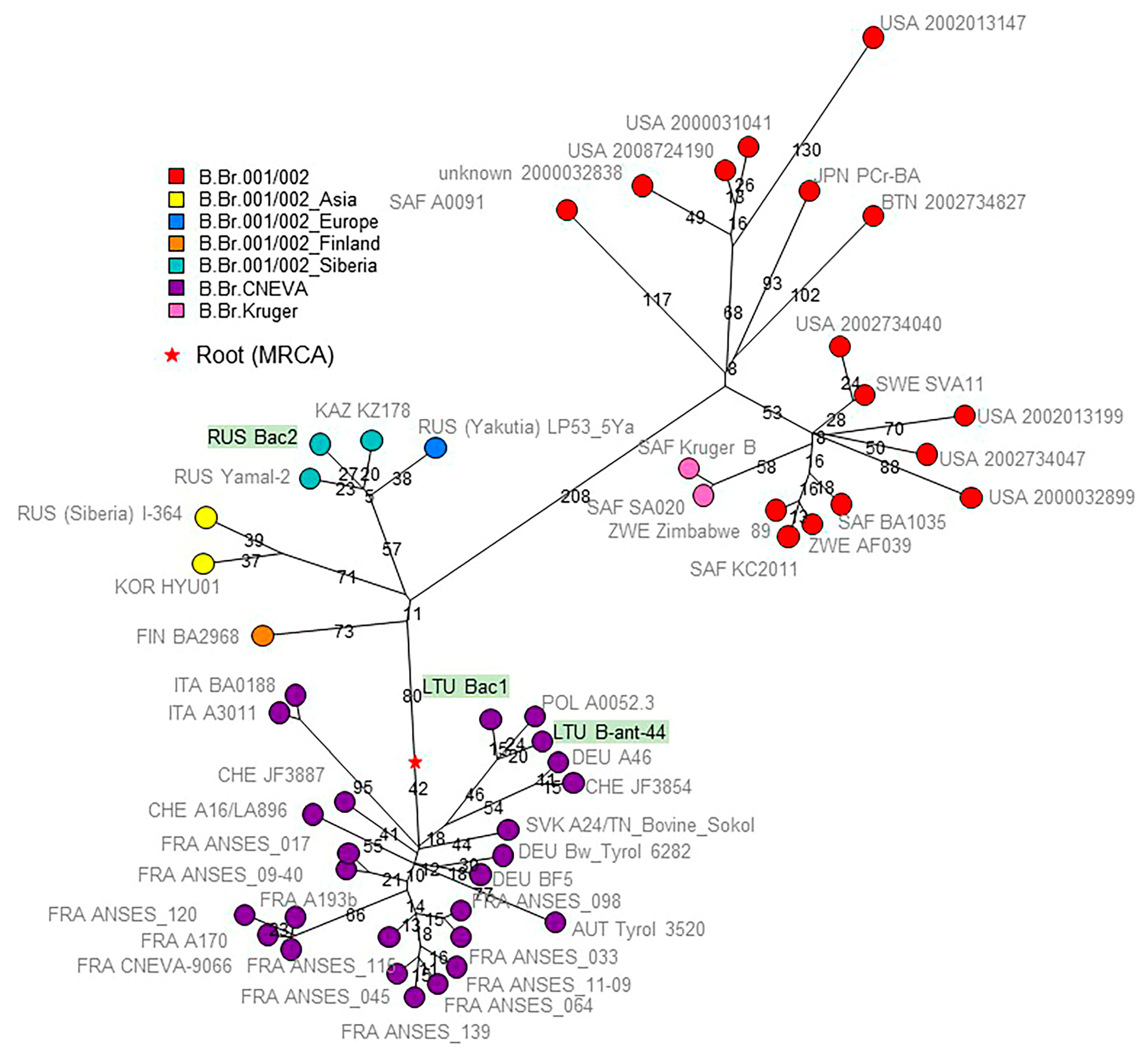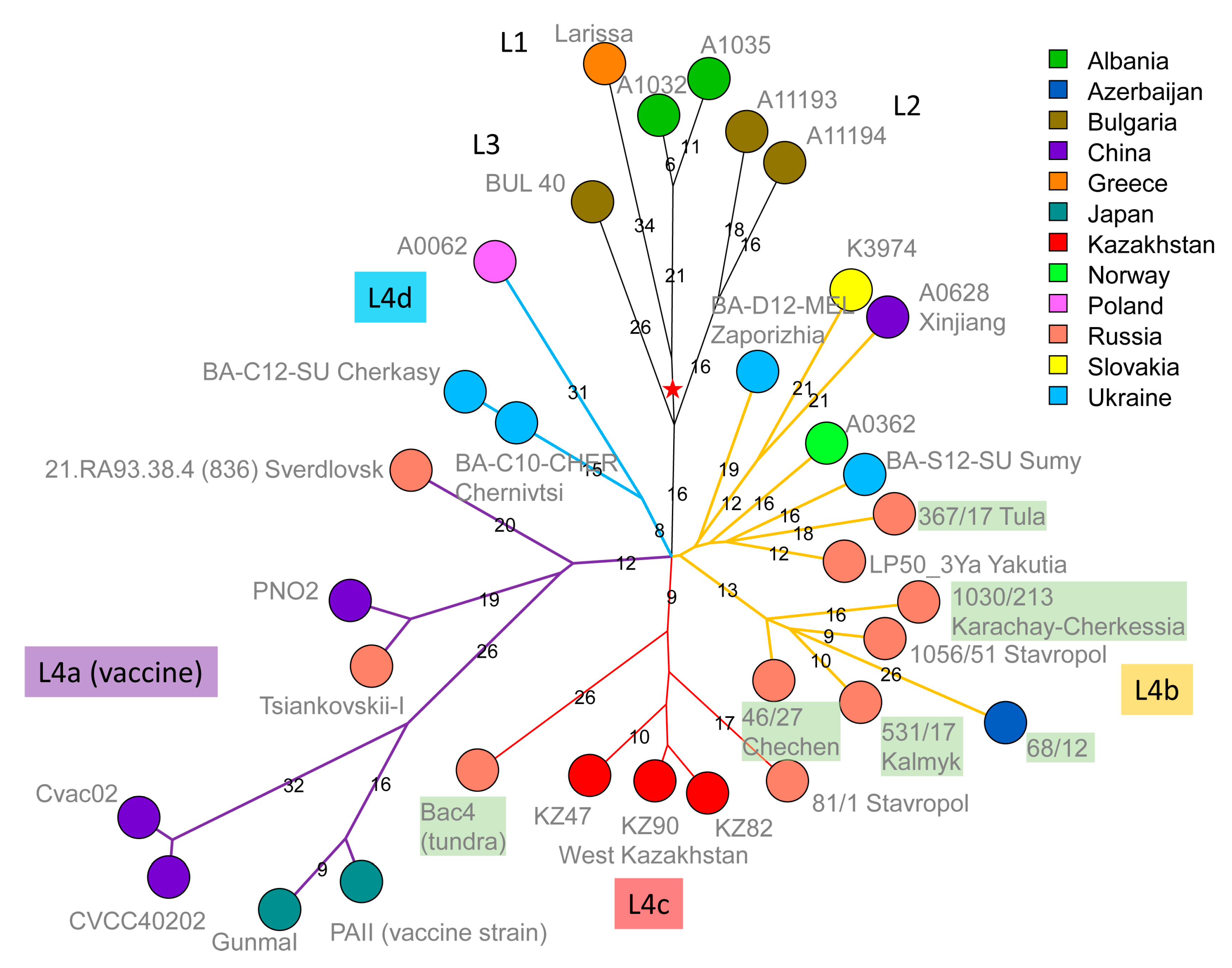New Research on the Bacillus anthracis Genetic Diversity in Siberia
Abstract
1. Introduction
2. Materials and Methods
2.1. Bacterial Culture, Strain Collection, DNA Extraction, and PCR Analyses
2.2. Draft Whole-Genome Sequencing (WGS)
2.3. Data Analysis
3. Results
3.1. Selection of Strains
3.2. MLVA Typing
3.3. Whole-Genome Sequence Analysis
3.4. canSNP Group Determination
3.5. Linking the Present Collection with the Stavropol Collection SNP Data
3.6. Comparison with Public WGS Datasets by Whole-Genome SNP (wgSNP) Analysis
4. Discussion
5. Conclusions
Supplementary Materials
Author Contributions
Funding
Institutional Review Board Statement
Informed Consent Statement
Data Availability Statement
Conflicts of Interest
References
- Jiranantasak, T.; Benn, J.S.; Metrailer, M.C.; Sawyer, S.J.; Burns, M.Q.; Bluhm, A.P.; Blackburn, J.K.; Norris, M.H. Characterization of Bacillus anthracis replication and persistence on environmental substrates associated with wildlife anthrax outbreaks. PLoS ONE 2022, 17, e0274645. [Google Scholar] [CrossRef] [PubMed]
- Hsieh, H.Y.; Stewart, G.C. Does environmental replication contribute to Bacillus anthracis spore persistence and infectivity in soil? Res. Microbiol. 2023, 174, 104052. [Google Scholar] [CrossRef] [PubMed]
- Timofeev, V.; Bahtejeva, I.; Mironova, R.; Titareva, G.; Lev, I.; Christiany, D.; Borzilov, A.; Bogun, A.; Vergnaud, G. Insights from Bacillus anthracis strains isolated from permafrost in the tundra zone of Russia. PLoS ONE 2019, 14, e0209140. [Google Scholar] [CrossRef]
- Kenefic, L.J.; Pearson, T.; Okinaka, R.T.; Schupp, J.M.; Wagner, D.M.; Hoffmaster, A.R.; Trim, C.B.; Chung, W.K.; Beaudry, J.A.; Jiang, L.; et al. Pre-Columbian origins for North American anthrax. PLoS ONE 2009, 4, e4813. [Google Scholar] [CrossRef]
- Van Ert, M.N.; Easterday, W.R.; Huynh, L.Y.; Okinaka, R.T.; Hugh-Jones, M.E.; Ravel, J.; Zanecki, S.R.; Pearson, T.; Simonson, T.S.; U’Ren, J.M.; et al. Global genetic population structure of Bacillus anthracis. PLoS ONE 2007, 2, e461. [Google Scholar] [CrossRef]
- Pearson, T.; Busch, J.D.; Ravel, J.; Read, T.D.; Rhoton, S.D.; U’Ren, J.M.; Simonson, T.S.; Kachur, S.M.; Leadem, R.R.; Cardon, M.L.; et al. Phylogenetic discovery bias in Bacillus anthracis using single-nucleotide polymorphisms from whole-genome sequencing. Proc. Natl. Acad. Sci. USA 2004, 101, 13536–13541. [Google Scholar] [CrossRef]
- Derzelle, S.; Thierry, S. Genetic diversity of Bacillus anthracis in Europe: Genotyping methods in forensic and epidemiologic investigations. Biosecur Bioterror 2013, 11 (Suppl. S1), S166–S176. [Google Scholar] [CrossRef]
- Pilo, P.; Frey, J. Pathogenicity, population genetics and dissemination of Bacillus anthracis. Infect. Genet. Evol. 2018, 64, 115–125. [Google Scholar] [CrossRef]
- Eremenko, E.; Pechkovskii, G.; Pisarenko, S.; Ryazanova, A.; Kovalev, D.; Semenova, O.; Aksenova, L.; Timchenko, L.; Golovinskaya, T.; Bobrisheva, O.; et al. Phylogenetics of Bacillus anthracis isolates from Russia and bordering countries. Infect. Genet. Evol. 2021, 92, 104890. [Google Scholar] [CrossRef]
- Simonson, T.S.; Okinaka, R.T.; Wang, B.; Easterday, W.R.; Huynh, L.; U’Ren, J.M.; Dukerich, M.; Zanecki, S.R.; Kenefic, L.J.; Beaudry, J.; et al. Bacillus anthracis in China and its relationship to worldwide lineages. BMC Microbiol. 2009, 9, 71. [Google Scholar] [CrossRef]
- Shevtsov, A.; Lukhnova, L.; Izbanova, U.; Vernadet, J.P.; Kuibagarov, M.; Amirgazin, A.; Ramankulov, Y.; Vergnaud, G. Bacillus anthracis Phylogeography: New Clues From Kazakhstan, Central Asia. Front. Microbiol. 2021, 12, 778225. [Google Scholar] [CrossRef]
- Fedotova, A.A. Veterinary trip of soil scientist P.A. Kostychev. Hist. Biol. Res. 2012, 4, 79–93. (In Russian) [Google Scholar]
- Hoang, T.T.H.; Dang, D.A.; Pham, T.H.; Luong, M.H.; Tran, N.D.; Nguyen, T.H.; Nguyen, T.T.; Nguyen, T.T.; Inoue, S.; Morikawa, S.; et al. Epidemiological and comparative genomic analysis of Bacillus anthracis isolated from northern Vietnam. PLoS ONE 2020, 15, e0228116. [Google Scholar] [CrossRef]
- Kravchenko, T.; Titareva, G.; Bakhteeva, I.; Kombarova, T.; Borzilov, A.; Mironova, R.; Khlopova, K.; Timofeev, V. Using a Syrian (Golden) Hamster Biological Model for the Evaluation of Recombinant Anthrax Vaccines. Life 2021, 11, 1388. [Google Scholar] [CrossRef] [PubMed]
- Derzelle, D.; Girault, G.; Kokotovic, B.; Angen, Ø. Whole Genome-Sequencing and Phylogenetic Analysis of a Historical Collection of Bacillus anthracis Strains from Danish Cattle. PLoS ONE 2015, 10, e0134699. [Google Scholar] [CrossRef] [PubMed]
- Vergnaud, G.; Girault, G.; Thierry, S.; Pourcel, C.; Madani, N.; Blouin, Y. Comparison of French and Worldwide Bacillus anthracis Strains Favors a Recent, Post-Columbian Origin of the Predominant North-American Clade. PLoS ONE 2016, 11, e0146216. [Google Scholar] [CrossRef] [PubMed]
- Vergnaud, G. Bacillus anthracis evolution: Taking advantage of the topology of the phylogenetic tree and of human history to propose dating points. Erciyes Med. J. 2020, 42, 362–369. [Google Scholar]
- Bassy, O.; Antwerpen, M.; Ortega-Garcia, M.V.; Ortega-Sanchez, M.J.; Bouzada, J.A.; Cabria-Ramos, J.C.; Grass, G. Spanish Outbreak Isolates Bridge Phylogenies of European and American Bacillus anthracis. Microorganisms 2023, 11, 889. [Google Scholar] [CrossRef] [PubMed]
- Antonation, K.S.; Grutzmacher, K.; Dupke, S.; Mabon, P.; Zimmermann, F.; Lankester, F.; Peller, T.; Feistner, A.; Todd, A.; Herbinger, I.; et al. Bacillus cereus Biovar Anthracis Causing Anthrax in Sub-Saharan Africa-Chromosomal Monophyly and Broad Geographic Distribution. PLoS Negl. Trop. Dis. 2016, 10, e0004923. [Google Scholar] [CrossRef] [PubMed]
- Pena-Gonzalez, A.; Rodriguez, R.L.; Marston, C.K.; Gee, J.E.; Gulvik, C.A.; Kolton, C.B.; Saile, E.; Frace, M.; Hoffmaster, A.R.; Konstantinidis, K.T. Genomic Characterization and Copy Number Variation of Bacillus anthracis Plasmids pXO1 and pXO2 in a Historical Collection of 412 Strains. mSystems 2018, 3, e00065-18. [Google Scholar] [CrossRef]
- Sahl, J.W.; Pearson, T.; Okinaka, R.; Schupp, J.M.; Gillece, J.D.; Heaton, H.; Birdsell, D.; Hepp, C.; Fofanov, V.; Noseda, R.; et al. A Bacillus anthracis Genome Sequence from the Sverdlovsk 1979 Autopsy Specimens. MBio 2016, 7, 10–1128. [Google Scholar] [CrossRef] [PubMed]
- Derzelle, S.; Aguilar-Bultet, L.; Frey, J. Whole genome SNP analysis of bovine B. anthracis strains from Switzerland reflects strict regional separation of Simmental and Swiss Brown breeds in the past. Vet. Microbiol. 2016, 196, 1–8. [Google Scholar] [CrossRef]
- Jung, K.H.; Kim, S.H.; Kim, S.K.; Cho, S.Y.; Chai, J.C.; Lee, Y.S.; Kim, J.C.; Kim, S.J.; Oh, H.B.; Chai, Y.G. Genetic populations of Bacillus anthracis isolates from Korea. J. Vet. Sci. 2012, 13, 385–393. [Google Scholar] [CrossRef] [PubMed][Green Version]
- Lienemann, T.; Beyer, W.; Pelkola, K.; Rossow, H.; Rehn, A.; Antwerpen, M.; Grass, G. Genotyping and phylogenetic placement of Bacillus anthracis isolates from Finland, a country with rare anthrax cases. BMC Microbiol. 2018, 18, 102. [Google Scholar] [CrossRef] [PubMed]
- Pisarenko, S.V.; Eremenko, E.I.; Ryazanova, A.G.; Kovalev, D.A.; Buravtseva, N.P.; Aksenova, L.Y.; Dugarzhapova, Z.F.; Evchenko, A.Y.; Kravets, E.V.; Semenova, O.V.; et al. Phylogenetic analysis of Bacillus anthracis strains from Western Siberia reveals a new genetic cluster in the global population of the species. BMC Genom. 2019, 20, 692. [Google Scholar] [CrossRef] [PubMed]
- Pisarenko, S.V.; Eremenko, E.I.; Kovalev, D.A.; Ryazanova, A.G.; Evchenko, A.Y.; Aksenova, L.Y.; Dugarzhapova, Z.F.; Kravets, E.V.; Semenova, O.V.; Bobrysheva, O.V.; et al. Molecular genotyping of 15 B. anthracis strains isolated in Eastern Siberia and Far East. Mol. Phylogenet Evol. 2021, 159, 107116. [Google Scholar] [CrossRef]
- Keim, P.; Price, L.B.; Klevytska, A.M.; Smith, K.L.; Schupp, J.M.; Okinaka, R.; Jackson, P.J.; Hugh-Jones, M.E. Multiple-locus variable-number tandem repeat analysis reveals genetic relationships within Bacillus anthracis. J. Bacteriol. 2000, 182, 2928–2936. [Google Scholar] [CrossRef]
- Lista, F.; Faggioni, G.; Valjevac, S.; Ciammaruconi, A.; Vaissaire, J.; le Doujet, C.; Gorge, O.; De Santis, R.; Carattoli, A.; Ciervo, A.; et al. Genotyping of Bacillus anthracis strains based on automated capillary 25-loci multiple locus variable-number tandem repeats analysis. BMC Microbiol. 2006, 6, 33. [Google Scholar] [CrossRef]
- Thierry, S.; Tourterel, C.; Le Fleche, P.; Derzelle, S.; Dekhil, N.; Mendy, C.; Colaneri, C.; Vergnaud, G.; Madani, N. Genotyping of French Bacillus anthracis strains based on 31-loci multi locus VNTR analysis: Epidemiology, marker evaluation, and update of the internet genotype database. PLoS ONE 2014, 9, e95131. [Google Scholar] [CrossRef]
- Goncharova, Y.O.; Bogun, A.G.; Bahtejeva, I.V.; Titareva, G.M.; Mironova, R.I.; Kravchenko, T.B.; Ostarkov, N.A.; Brushkov, A.V.; Timofeev, V.S.; Ignatov, S.G. Allelic Polymorphism of Anthrax Pathogenicity Factor Genes as a Means of Estimating Microbiological Risks Associated with Climate Change. Appl. Biochem. Microbiol. 2022, 58, 382–393. [Google Scholar] [CrossRef]
- Goncharova, Y.; Bahtejeva, I.; Titareva, G.; Kravchenko, T.; Lev, A.; Dyatlov, I.; Timofeev, V. Sequence Variability of pXO1-Located Pathogenicity Genes of Bacillus anthracis Natural Strains of Different Geographic Origin. Pathogens 2021, 10, 1556. [Google Scholar] [CrossRef] [PubMed]
- Eremenko, E.I.; Ryazanova, A.G.; Pisarenko, S.V.; Buravtseva, N.P.; Pechkovsky, G.A.; Aksenova, L.Y.; Semenova, O.V.; Varfolomeeva, N.G.; Golovinskaya, T.M.; Chmerenko, D.K.; et al. New Genetic Markers for Molecular Typing of Bacillus anthracis Strains. Probl. Part. Danger. Infect. 2019, 3, 43–50. (In Russian) [Google Scholar] [CrossRef]
- Liang, X.; Zhang, H.; Zhang, E.; Wei, J.; Li, W.; Wang, B.; Dong, S.; Zhu, J. Identification of the pXO1 plasmid in attenuated Bacillus anthracis vaccine strains. Virulence 2016, 7, 578–586. [Google Scholar] [CrossRef] [PubMed]




Disclaimer/Publisher’s Note: The statements, opinions and data contained in all publications are solely those of the individual author(s) and contributor(s) and not of MDPI and/or the editor(s). MDPI and/or the editor(s) disclaim responsibility for any injury to people or property resulting from any ideas, methods, instructions or products referred to in the content. |
© 2023 by the authors. Licensee MDPI, Basel, Switzerland. This article is an open access article distributed under the terms and conditions of the Creative Commons Attribution (CC BY) license (https://creativecommons.org/licenses/by/4.0/).
Share and Cite
Timofeev, V.; Bakhteeva, I.; Khlopova, K.; Mironova, R.; Titareva, G.; Goncharova, Y.; Solomentsev, V.; Kravchenko, T.; Dyatlov, I.; Vergnaud, G. New Research on the Bacillus anthracis Genetic Diversity in Siberia. Pathogens 2023, 12, 1257. https://doi.org/10.3390/pathogens12101257
Timofeev V, Bakhteeva I, Khlopova K, Mironova R, Titareva G, Goncharova Y, Solomentsev V, Kravchenko T, Dyatlov I, Vergnaud G. New Research on the Bacillus anthracis Genetic Diversity in Siberia. Pathogens. 2023; 12(10):1257. https://doi.org/10.3390/pathogens12101257
Chicago/Turabian StyleTimofeev, Vitalii, Irina Bakhteeva, Kseniya Khlopova, Raisa Mironova, Galina Titareva, Yulia Goncharova, Viktor Solomentsev, Tatiana Kravchenko, Ivan Dyatlov, and Gilles Vergnaud. 2023. "New Research on the Bacillus anthracis Genetic Diversity in Siberia" Pathogens 12, no. 10: 1257. https://doi.org/10.3390/pathogens12101257
APA StyleTimofeev, V., Bakhteeva, I., Khlopova, K., Mironova, R., Titareva, G., Goncharova, Y., Solomentsev, V., Kravchenko, T., Dyatlov, I., & Vergnaud, G. (2023). New Research on the Bacillus anthracis Genetic Diversity in Siberia. Pathogens, 12(10), 1257. https://doi.org/10.3390/pathogens12101257






